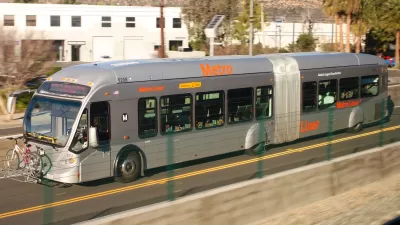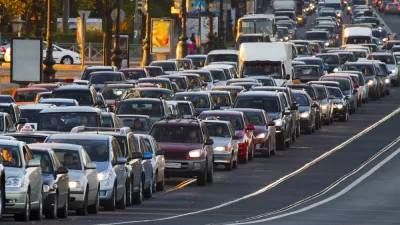The American Public Transit Association reports that transit ridership climbed to 10.3 billion trips during the first quarter of 2008, the “highest number of trips taken in fifty years.” That represents a 3.3 percent increase overall over the previous year while vehicle miles traveled, a measure of demand for car travel, fell by 2.3 percent, they observe.
The American Public Transit Association reports that transit ridership climbed to 10.3 billion trips during the first quarter of 2008, the "highest number of trips taken in fifty years." That represents a 3.3 percent increase overall over the previous year while vehicle miles traveled, a measure of demand for car travel, fell by 2.3 percent, they observe.
But what do these statistics mean for US travel more generally? Not much. At best, they reinforce transit's modern-day role as a niche transportation choice. At worst, they're a harbinger of transit's continued long-term decline. Here's why.
First, let's acknowledge that the increase in ridership is significant. If we convert ridership into passenger miles traveled-a distance-based rather than trip-based measure-a 3.3 percent increase translates into 1.6 billion passenger miles over the course of a year. That's a lot, particularly given the hurdles faced by transit in a high-end, services-based economy that demands more transportation flexibility and generates complex travel patterns. (This, btw, is the subject of my next book, Mobility First, due out this November.)
Yet, APTA's juxtaposition of the two numbers-transit ridership (trips) versus vehicle miles traveled (distance)-is misleading. Their reporting incorrectly implies that public transit is gaining on automobile travel. It isn't. In fact, it's losing ground. Transit's market share of all travel fell from 1.5% of all travel in 1980 to 1.0% in 2005 according to the U.S. Department of Transportation. Even with the gains in ridership, transit would be lucky to maintain its current market share, let alone forestall its long-term decline.
Public transit's gains also pale in comparison to the reduction in road-based travel. US travelers eliminated 112 billion passenger miles from our roadways in 2007. Fewer than 2 percent of those trips might have shifted to public transit even if we assume all of those passenger miles migrated onto buses and trains.
Notably, APTA pointed out that light rail, commuter rail, and heavy rail experience significant increases. But light rail only accounts for 3.4% of transit passenger miles nationally. Commuter and heavy rail together account for almost half of public transit ridership, but their growth was just 5.7% and 4.4% respectfully. Gas prices, in contrast, have increased by about 50 cents (14%) over the last year.
So, anyway you slice the pie, public transit's gains are much more modest than APTA's press release suggests, and the impact on overall travel patterns is minor despite higher gas prices. The data show that the public is not exactly "embracing" transit as an alternative to higher gas prices. Rather, they are simply cutting down on travel. It's not time to re-plan our regions based on or around transit's resurgence.

Manufactured Crisis: Losing the Nation’s Largest Source of Unsubsidized Affordable Housing
Manufactured housing communities have long been an affordable housing option for millions of people living in the U.S., but that affordability is disappearing rapidly. How did we get here?

Americans May Be Stuck — But Why?
Americans are moving a lot less than they once did, and that is a problem. While Yoni Applebaum, in his highly-publicized article Stuck, gets the reasons badly wrong, it's still important to ask: why are we moving so much less than before?

Using Old Oil and Gas Wells for Green Energy Storage
Penn State researchers have found that repurposing abandoned oil and gas wells for geothermal-assisted compressed-air energy storage can boost efficiency, reduce environmental risks, and support clean energy and job transitions.

Updating LA’s Tree Rules Could Bring More Shade to Underserved Neighborhoods
A new USC study finds that relaxing Los Angeles’ outdated tree planting guidelines could significantly expand urban tree canopy and reduce shade disparities in lower-income neighborhoods, though infrastructure investments are also needed.

California's Canal Solar Projects Aim to Conserve Resources and Expand Clean Energy
California’s Project Nexus has begun generating electricity from solar panels installed over irrigation canals, with researchers and state agencies exploring statewide expansion to conserve water and boost clean energy production.

HHS Staff Cuts Gut Energy Assistance Program
The full staff of a federal program that distributes heating and cooling assistance for low-income families was laid off, jeopardizing the program’s operations.
Urban Design for Planners 1: Software Tools
This six-course series explores essential urban design concepts using open source software and equips planners with the tools they need to participate fully in the urban design process.
Planning for Universal Design
Learn the tools for implementing Universal Design in planning regulations.
Heyer Gruel & Associates PA
City of Moreno Valley
Institute for Housing and Urban Development Studies (IHS)
City of Grandview
Harvard GSD Executive Education
Salt Lake City
NYU Wagner Graduate School of Public Service
City of Cambridge, Maryland






























